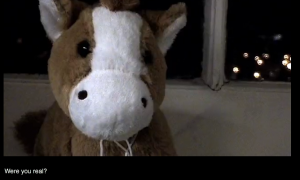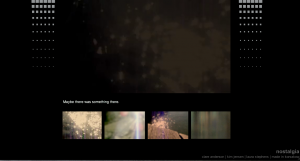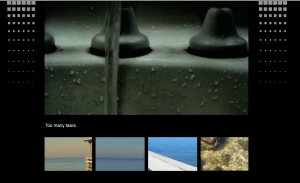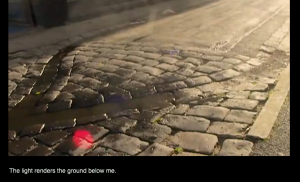Monthly Archives: April 2014
Integrated Media – Participation Contract – Week 7
Integrated Media 01 – Sketch Film
Korsakow Sketch Project: The Hollow
Integrated Media – Participation Contract – Week 6
Film-TV1- Analysis/Reflection 3 – Question 3
From the week 4 lecture describe at least two reasons why we ‘shoot to edit’?
We ‘shoot to edit’ so that scenes can be shot out of order and in a methodical way. For example, this may mean shooting all your exterior shots and then all your interior shots. This also allows efficiency as priority shots, due to time or location restraints, can be done first.
Secondly, by ‘shooting to edit’ we shoot a range of takes. This certifies that when we get to the editing stage there is a variety of material to make a desired decision. More footage means more options; therefore we have to be mindful when shooting to do such things as roll the camera a few seconds at the start and end of the shot.
Integrated Media 01 – Film Essay – Nostalgia
Korsakow Film: Nostalgia, 2010
Makers: Clare Anderson, Laura Stephens and Wichaya Kim Jensen
Nostalgia: a sentimental longing or wistful affection for a period in the past. So how do you construct thoughts or memories when the way a person remembers is never the exact way something occurred? This ideal can be seen in the student Korsakow project film Nostalgia, which creates a haphazard collection of emotions in a way that would be remembered. Unlike a narrative, what David Bordwell would define as, “a chain of events in cause-effect relationship occurring in time and space,” Nostalgia presents time and space as an ideal rather than an occurrence. The project has no pre-established order to look through the clips and after a while you find yourself unravelling the interweaving of what it is to remember.
The work relies on the pattern of emotion to drive the piece forward. It uses the style of film and content to link some pieces as we see blurry shot clips link to each other, rain and water shots link to the beach and ocean, and more sombre shadowed clips link together.
 There is also the existence of SNUs that are not a common occurrence having only one ‘in’ link, for example a stuffed horse toy with the caption, “Were you real?” This technique keeps the piece fresh and a constant discovery.
There is also the existence of SNUs that are not a common occurrence having only one ‘in’ link, for example a stuffed horse toy with the caption, “Were you real?” This technique keeps the piece fresh and a constant discovery.
Closely under the main pane, text is sharply contrasted in white against the black background. The content of the text is not a direct reflection of what is happening in the clip, but it does form some relationship; for example when the text states, “Maybe there was something there,” we see a blurry shot we can’t clearly make out.

Furthermore, the lines of text also begin to form a collection of feelings, ideals and emotions. For example, “Just waiting patiently trying to conform,” could relate to acceptance, “I wonder if you’ll still shine like you did before,” hope, “I found it hard to draw the line between the chaos outside myself and the chaos within,” the constant struggle of the human psyche. Ian Bogost emphasises the importance of lists as they, “remind us that no matter how fluidly a system may operate, its members nevertheless remain isolated, mutual aliens.” In the piece the text explains an emotion of the moment and isolates it from any other feeling.
As Adrian notes in his write up on the project, the ability to click away from the opening credits and get started on watching the film shows an, “awareness of the user as a consequence.” It not only makes the piece driven on the audience’s character (as some will not have the patience to wait; while others will happily ponder) but also makes the audience feel like they have more control over the project. The main video pane is housed in the middle of the screen, with a line of text closely under and four smaller linking thumbnails below. The interface is well balanced and the centrality creates a direct user experience therefore commanding attention to the main screen. There is a simplicity and neatness which makes navigation of the interface seamless, providing a juxtaposition of an ordered image to an unmethodical collection of thoughts and emotions portrayed in the work. It’s also interesting to note that clips do not repeat after they have been played or begin to play when you hover your mouse over the linking SNU. This serves the ideal of capturing something in a moment; in life you don’t get the option to relive something exactly over again so it wouldn’t seem appropriate to here.
Nostalgia uses a black background with a geometric square pattern graphic symmetrically placed on each side of the main player as a canvas for the project. The graphics provide a frame for the work, directing the viewers’ attention and also adding depth. The effect is almost a filtered look as the squares fall down the page to get smaller and smaller, this could relate metaphorically to the formation of links in the Korsakow project as it begins broadly and then becomes more and more connected, or it could relate to water as it looks like rain falling.


A main theme throughout the piece is the subject matter of water – a universal code for youth and life’s beginning – it not only emotes the feeling of nostalgia but adds a rhythm in its fluidity. Water is also commented on in the text, as “Drowning without being submerged,” and “Too many tears,” plays on the ideal. In the project, the manner in which different shots are filmed elicits different emotional ploys, such as the adjusting focus shot of, “The light renders the ground below me,” creating the effect of just waking up to the beginning of something.
The shots are very poetic and most of the time they never show content in full view, always being parts of objects; like feet or a pier. There is also a lack of people in the shots or more so not a focus on them, this allows a more personal experience with the work and also emphasises shots like, “I searched for comfort in other people’s faces.” In this shot we see people but don’t connect with them as they simply pass by, establishing a sense of isolation.
Music is crucial to the piece, with a different track played with each clip. The music is un-lyrical which allows it and the text to form a relation in creating some sort of song. Adrian does question whether a single continuous soundtrack would have been more effective, and even though it does get a little clunky having to wait for the new music to start and videos to load, it’s worth it as each track asks for a different emotional response from the viewer, drawing them into this evolution of thought and feeling. Music is also used to evoke emotion, for example piano music used in more sombre clips of the piece.
Throughout the work the average duration of clips is not long, relating to the idea of memories not encompassing long sequences but when accessed in our thoughts are simply snippets of moments. After thorough navigation of the piece you realise there is no ending SNU, the clips loop on infinitely; as a mind would. All these techniques promote the idea of the project representing the evolution of thought and memories, but I believe the film is trying to represent the more sombre; the ideal of nostalgia not being able to bring back moments but simply redefine loneliness.
References
Anderson, Clare; Jensen, Kim and Stephens, Laura. “Nostalgia.” Korsakow. 2010: http://vogmae.net.au/classworks/media/2010/kfilms/nostalgia/, March 2014. (screen shots and text quotes)
[Extract] Bogost, Ian. Alien Phenomenology, or What It’s Like to Be a Thing. Minneapolis: University Press of Minnesota, 2012. Print.
Bordwell, David and Kristin Thompson. Film Art: An Introduction. New York, N.Y.: McGraw-Hill, 2013. Print.
Miles, Adrian. “Nostalgia.” Classworks – Interactive online video work by media undergrads. 2010: http://vogmae.net.au/classworks/2010/Nostalgia.html





